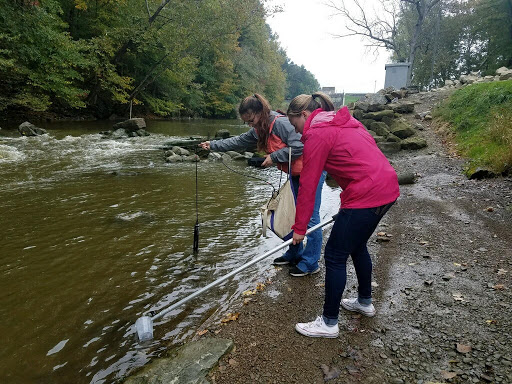AUWQUA: AU’s water testing group

Ashland University students, Alexis Flagg (left) and Emily Fulk (right) track physical and chemical parameters and sample surface water in the Black Fork of the Mohican River, downstream from the Charles Mill Lake Dam.
November 20, 2018
In a practical application of science, an interdisciplinary group on campus is working to maintain a long-term water quality monitoring project at the Ashland University Black Fork Wetlands Preserve.
AUWQUA, pronounced like aqua, is AU’s Water Testing Group. They monitor water quality over time and any changes that may occur as a result of agriculture, industry or other types of development in the community.
The data collected can also be used to inform the authorities on land use for best practices in order to maintain or improve water quality.
“Right now we’re at a phase where we are just building a baseline. No one has really been paying that much attention to the water quality in Black Fork, and so we go out once a month,” Professor Jenna Dolhi, Professor of Biology and AUWQUA Project Director said. “If there was some sort of abnormality, we would watch that pretty closely, and water quality is going to be changing month to month.”
The group collects water samples from the Black Fork of the Mohican River and the Black Fork Wetlands once a month to measure water temperature, pH, dissolved oxygen, salinity and conductivity on site.
“The goal is basically to see different variations in the water as the seasons change and as the months goes on. Since we are in a pretty agricultural area where there are going to be a lot of run of in the field and some of that flushes into the water,” Alexis Lough, a forensic science major and water sampler/analysis in the project said. “The water system ultimately runs out into other bodies of water, so it is going to affect organisms that are in the water and downstream into other bodies of water.”
Water is taken from the Black Fork River for the fracking process which may cause less water in the system.
“I don’t know that it would be enough to drastically alter the water quality there, but if there is less water in the system then we could be seeing more concentration of nutrients, like agriculture nutrients (nitrates and phosphorus) or just concentration of sediment and ions, so those things will impact the organisms that live there,” Dolhi said.
The project started collecting samples in July of 2017 among 13 different sites along the river.

Ashland University student, Emily Fulk, tracks physical and chemical parameters in the Black Fork of the Mohican River in real time using a multiprobe tool.
“I do think at this point we have a solid baseline of water quality data, we have a picture now of what the water quality is like in the Black Fork and that’s going to make us better positioned to then say ‘what kind of impact could this oil and gas industry coming in to the area have on water quality?’”Dolhi said.
The group has a diverse number of students from different majors cooperating to a one common goal.
“One of the nice outcomes of the club so far is that the students that have been involved for [about] a year are now really familiar with some of the processes and they are kind of running things on their own,” Dolhi siad. “It’s a really unique experience and really empowering for an undergraduate student to be able to do that. We’ve had almost 30 students involved in some aspect, whether it be the field sampling, or the lab work or the computer science side. It’s been a way for more students to get some research experience and scientific discovery experience rather than myself and two or three of my other faculty doing independent research projects.”
Juliann Dodd is a freshman student studying Toxicology and Biology. She learned about the project from her professor and joined the group in during her first month of school.
“I love nature and I love this type of stuff, so I really enjoy being able to go out into the wild and be with professors that can tell me a little bit more about it,” Dodd said. “Usually I am in the classroom and reading about it, but in this aspect, she is there with me and can give more information.”
The project is open to all students to join and be part of the team to monitor the water quality around the area. Students do not have to be a science major as long as they have interest and a passion for science. Working in the project can count as volunteering independently or as part of coursework.
“It is really nice that Ashland University offers the opportunity that a freshman can get into that type of research, because I know at a lot of other places you have to be older and be taught how to use the instruments, but I am right there working with upperclassmen, and I think it is cool,” Dodd said.
For more information about the project and to view reports and data collected, visit: https://www.auwqua.com


